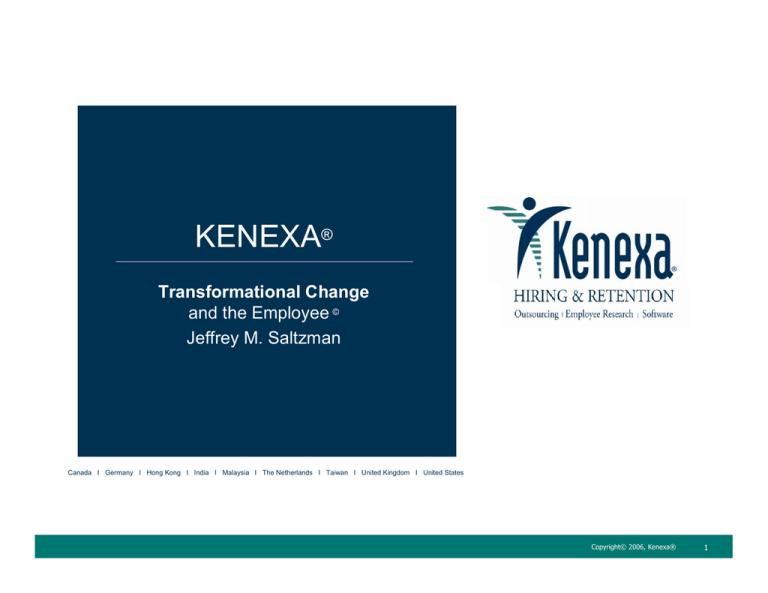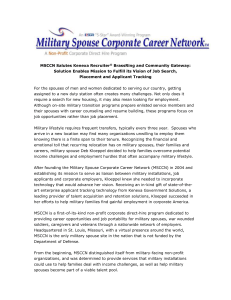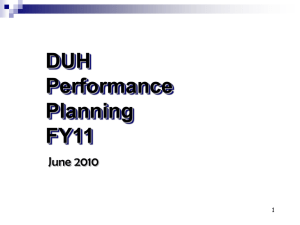KENEXA Transformational Change and the Employee Jeffrey M. Saltzman
advertisement

KENEXA® Transformational Change and the Employee © Jeffrey M. Saltzman Canada I Germany I Hong Kong I India I Malaysia I The Netherlands I Taiwan I United Kingdom I United States Copyright© 2006, Kenexa® 1 Definitions Transform: To change something dramatically – to change people or things completely, especially improving their appearance or usefulness; To undergo total change - to change completely for the better • Organization: Group – a group of people identified by shared interests or purpose • Employee: Paid worker – someone who is paid by someone else to do work • (Encarta North American Dictionary) Whether a transformation is a success or failure may depend on your point of view Copyright© 2006, Kenexa® Goals of Session • • • Examine basic needs of employees during organizational transformations Examine the organization/employee interface in transformations Describe cultural environmental variables to control during transformations Copyright© 2006, Kenexa® Traits Employee Organization Personality characteristics • Learned KSA’s • Innate ability • Survival instincts • • Organizational characteristics • Learned KSA’s • Survival instincts Copyright© 2006, Kenexa® Are any of these Goals of Your Organization? • • • • • • Benchmarking Best Performance? Best in Class? Maintaining the Success of the Status Quo? Evolving/Reliance on Legacy Systems? Erecting Barriers to Competition? Incremental Cost Reductions? Incremental Service Enhancements? These are all doomed to failure if the goal is transformation. Transformational change requires radical thinking. Copyright© 2006, Kenexa® Pitfalls in Transforming a Dead Horse Dakota tribal wisdom says that when you discover you are riding a dead horse, the best strategy is to dismount. Some organizations try other strategies with dead horses before dismounting, including: • Buying a stronger whip. • Changing riders. • Say things like, "This is the way we have always ridden this horse.“ • Appointing a committee to study the horse. • Arranging a benchmarking visit to see how others ride dead horses. • Increasing the standards to ride dead horses. • Appointing a working group to revive the dead horse. • Creating a training session to increase our riding ability. • Compare the state of dead horses in today’s environment. Copyright© 2006, Kenexa® Pitfalls in Transforming a Dead Horse • • • • • • • • • • Hire consultants to ride the dead horse for you. Create a form to complete to enable you to ride better. Harness several dead horses together for increased speed. Provide additional funding to increase the horse's performance. Do an analysis to see if contractors can ride cheaper then employees. Purchase a product to make dead horses run faster. Declare the horse is "better, faster and cheaper" dead. Form a cross functional group to find uses for dead horses. Revisit the performance requirements for horses. Promote the dead horse to an executive position. (Modified from the Achieves of Humor) Copyright© 2006, Kenexa® Principles of Transformational Change • • • Manage for the present Selectively forget the past Strategize for the future (Adapted from 10 Rules for Strategic Innovators) Employees have current needs to be met, should not be tied to legacy policies and practices and need to be prepared to succeed in new environment Copyright© 2006, Kenexa® Slack and Redundancy – Incremental vs. Transformational Improvements • In order to constantly improve performance, room must be made in the organization for the investigation, the vetting of alternative methods and procedures – slack and redundancy are critical ¾ Redundancy is when two different approaches are available to achieve a desired outcome, so that one can be measured against the other ¾ Slack is when additional resources are available to enable different paths to be tested • Critical systems are often multiply redundant, especially when failure of one system could lead to mission failure, death or injury • Constantly evaluating new processes and procedure prior to “go-live” can greatly enhance confidence for a successful transition Copyright© 2006, Kenexa® Slack and Redundancy – Incremental vs. Transformational Improvements Success Must Be Assured Start-up Blueprinting Fail Pass Pass Pass Implementation Fail Deployment Fail Pass Sustainment Fail Copyright© 2006, Kenexa® Transformational Goal Setting “There is no such thing as a perfect organization, only a vision of perfection that one can strive for only to find that it is constantly somewhat out of reach.” • Goal setting is a moving target Transformational goals are often initially viewed as unrealistic but can generate excitement “..this nation should commit itself to achieving the goal, before this decade is out, of landing a man on the moon and returning him safely to the earth .” - JFK Copyright© 2006, Kenexa® What Employees Want in Transforming Organizations • All employees fundamentally want the same basic things out of the work environment. • These fundamentals cut across organizations, cultures, gender, ethnic lines, positions, geographies and generations. • Employees are products of their environments and their humanness. ¾ Copyright© 2006, Kenexa® Myth? Two of Many…. • Technical people are naturally more cynical than others. Survey results with this group will be less favorable. • The younger generation does not care about job security. Were they born that way, or have they been shaped by their experiences? Copyright© 2006, Kenexa® Intentional Stance - Innate • The assumption on the part of a person that an event carries with it intelligent intent ¾ ¾ ¾ Survival mechanism Has transitioned from the savannah to the office Is exacerbated in times of high tension and change Copyright© 2006, Kenexa® Tenure Pattern – Innate or Learned? Copyright© 2006, Kenexa® Tenure Pattern Why? New employees come in with a high level of excitement, a can do attitude. Then…. • • • • • Job not what they thought it would be Out of training No longer getting same degree of attention Wondering why their brilliance not recognized/Advancement Dealing with the more frustrating components of working through organizational ineffectiveness and bureaucracy to get their work done Copyright© 2006, Kenexa® Tenure Pattern • At 3-5 years serious questioning. Did I make the right career decision? Is this the right company for me, the right industry? Should I jump? • People who make it through that period of introspection, of questioning, begin to see a long-term career being possible ¾ Cognitive dissonance also comes into play: if I am investing so much time here, it must be good, because if it wasn’t, I am not making good decisions Copyright© 2006, Kenexa® Disillusioned Employees Show Attitude Decline in: • Message: consistency of policy and communications. • Performance: organizational effectiveness, being efficient, planning, innovativeness, decision making timeliness, and training for one’s job. ¾ All of these diminishing ones ability to actually perform on the job, people get frustrated by not being able to get their jobs done. ¾ Employees want to do a good job. • Future: rewards and recognition (especially dissatisfaction with pay) and considerate treatment. Copyright© 2006, Kenexa® Attraction Numbers - Extremes • For 1800 position openings one federal agency receives 400,000 applicants, 222 applicants for each opening (HR Mag) • Today to recruit a mechanical engineer in the oil and gas industry, 75 to 100 potential candidates needed, in 2004, 25 to 30 candidates sufficed. (Workforce Mgmt) Copyright© 2006, Kenexa® “The War on Talent” • • • • • • • Pre 9/11, US Air Marshall Service had 33 agents covering 26,000 flights Post 9/11, 200,000 people applied for the 2,500 – 4,000 new spots created, 50-80 for each position Grueling schedules, lack of advancement, onerous rules affecting ability to get job done, lack of identity protection have resulted in “many” (in the words of other Marshalls) quitting the Service. The head of the Service called the complainers “disgruntled amateurs, insurgents, and organizational terrorists” Marshalls joined a union New head has begun to make changes (e.g. loosening dress code, steps to protect identity) (Wall Street Journal Feb 9, 2007) Copyright© 2006, Kenexa® People are Different • • • • People innately are different Cultures are different Men and women are different There are very different opinions around the world regarding cultural norms, i.e. ¾ the appropriate age of a person to marry, or if the wedding itself should be an arranged marriage ¾ differences in dress and religious belief among thousands of other things Not arguing that there is an artificial uniformity that doesn’t exist Copyright© 2006, Kenexa® Within Group Variation vs. Across Group Variation However, within a group (men or Asians or lawyers etc.) you will often find more variability then across groups. Copyright© 2006, Kenexa® What is the Point? • The point is when you look at the world of work there is a uniformity of what people hope for the employer to provide. ¾ ¾ • This is true regardless of gender, geographic, ethnic, cultural or generational differences. This is also true when organizations are undergoing transformational change Due to economic differences, cultural differences and a myriad of other things, how you deliver on that uniformity may be different. Copyright© 2006, Kenexa® The Search for Consistency The need for consistency is pervasive • • • People are looking for consistency in their personal lives. Organizations are looking for consistency as they deal with other organizations. Customers are looking for consistency as they interact and purchase either products or services. Transformation creates inconsistency in certain aspects of organizational life Copyright© 2006, Kenexa® Consistency - A Unique Crossroads Individual behavior and organizational behavior find common ground. • People want consistency “The discomfort of cognitive dissonance occurs when things fall out of alignment, which leads us to try to achieve a maximum practical level of consistency in our world.” – Festinger • People have a strong innate desire for consistency. Copyright© 2006, Kenexa® Consistency - A Unique Crossroads Organizations need consistency An organization that makes maximal use of consistency in their performance: • From a product standpoint (uniformity of product – zero defects) • From a customer service standpoint (the customer has a similar experience each and every time) • From an employee management standpoint Will outperform and help maximize performance Copyright© 2006, Kenexa® Superstitious Behavior • Baseball fans will likely have noticed that many players have routines they follow prior to going to the plate or mound, between swings, or after hitting a home run. • While making the player feel better (because of the belief that it will somehow help their performance) it is not actually needed for successful performance. • Although some players would probably argue with that statement. People and organizations need to be consistent on things that count. Copyright© 2006, Kenexa® Superstitious Behavior: Not limited to Human Beings • B.F. Skinner placed pigeons in a cage, with food dispensed randomly. • Pigeons spontaneously developed behaviors, trying to cause the food to be dispensed; They developed superstitions. • If I do this and this, followed by this, a food pellet will appear, when in actuality the food pellet appeared randomly. • If pellet did not appear, they continued the pattern until the food pellet appeared. Copyright© 2006, Kenexa® The Employee at Work Most employees want to do a good job at work. A small portion of employees do not fit this statement and unfortunately organizations generally create rules for this subset rather than the majority. They manage for the exception. “You must not lose faith in humanity. Humanity is an ocean; if a few drops are dirty, the ocean does not become dirty.” Mahatma Gandhi Copyright© 2006, Kenexa® Creating Consistency The fundamentals of creating consistency for employees in the work environment first centers around content and consistency of Message, describing for employees what the organization is about and their role in achieving that goal and then sticking to that message. Copyright© 2006, Kenexa® Creating Consistency • Secondly, the organization needs to provide the employee what they need to get their jobs done – Performance • Thirdly, the employee needs to feel appreciated for what they have accomplished and see a Future for themselves within the organization “So much of what we call management consists in making it difficult for people to work”. - Peter Drucker Copyright© 2006, Kenexa® MPFO Framework© Message: Am I sending the right Message in a consistent fashion throughout all the levels of my organization? Do people know what is expected of them? 2 Future Performance Performance: Are people getting what they need (in the broadest sense) to be able to deliver on that Message – to get the job done? Optimum Performance 3 1 Future: Do people feel like they have a Future and a sense of belonging with this organization? Message Optimum Performance: The Outcomes associated with MPF Copyright© 2006, Kenexa® Message • Providing the strategy, tactics and goals of the organization and individuals role in achieving goals. ¾ Mission, Vision and Values disseminated • Getting the Message right, identifying those attributes at which this organization needs to truly excel is the key as is. ¾ Consistency in delivering on that Message • No organization can do everything - pick those things that are critical to your organization’s success. ¾ Be consistent but if you have the wrong Message in place adapt. Copyright© 2006, Kenexa® Performance • Providing people what they need to deliver on the Message, typically a long list, varying by organization. • Including: business processes, tools and equipment, training, staffing, safety, communications, cooperative environment, fair and honest treatment, good supervision, adequate benefits, sound business financial model, etc. • Performance criteria should be the ones that will really make a difference for the organization. Copyright© 2006, Kenexa® Future Providing a sense of belonging, a sense that the organization is concerned about them as people and that they have a solid Future with the organization if they stay. Includes job security, advancement, development, and recognition. “Appreciation is a wonderful thing. It makes what is excellent in others belong to us as well”. -Voltaire Copyright© 2006, Kenexa® Optimum Performance – The Center Dependent Measures • The employee: Sense of accomplishment, pride, company and job satisfaction, and engagement. Employee willing to go above and beyond in service to the customer and to solve problems. • The citizen/customer: Better interactions with members of your organization, receiving higher quality service and products, and increased repurchase intentions. • The organization: Higher levels of effectiveness, efficiency, and greater retention rates among other positive business outcomes. Copyright© 2006, Kenexa® Sub-optimum Conditions Message and Performance without Future: (1) • Employees know what they have to do and are given what they need to perform, however… • No sense of a long-term future 2 Future • • • Feel like piece on a chess board, as needed will be shuffled around or laid off Low commitment/engagement ¾ Searching for better opportunities elsewhere if not immediately then as soon as other factors become intolerable Performance Optimum Performance 3 1 Message Customers (external or internal) experience disinterested employees Copyright© 2006, Kenexa® Sub-optimum Conditions Performance and Future without Message: (2) • Changing priorities and goals • People are not sure what they should be working on or who is responsible for what outcomes • • • There is little accountability and much rework because final products and goals are unclear Organization often times do not get traction on the growth curve or growth is viewed as haphazard 2 Future Performance Optimum Performance 3 1 Message Customers experience inconsistency Copyright© 2006, Kenexa® Sub-optimum Conditions: Future and Message without Performance: (3) • • These are organizations that have strategy and goals, tell people they are important, give them lots to do, but don’t supply what they need to get their jobs done 2 Future Performance Impossibly high work loads Optimum • Sense of poor processes and effectiveness • Leadership is viewed as ineffective • Customers experience poor service and product quality often times only made up for by having people working so hard Performance 3 1 Message Copyright© 2006, Kenexa® How might this be summarized? Framework Experience Through Message Personal Performance Goals Performance Future Base Pay Working Conditions Benefits Supervision Workload Use of skills Training Tools/Equipment Cooperation & Teamwork Communication Innovation Decision Making Resources Merit increases Psychological Rewards Advancement Development Opportunities Meaningful Work Job Security = Yielding Optimized Performance Knowing what organization stands for etc… Varies upon local conditions Knowing where organization is going Operationalized Copyright© 2006, Kenexa® Long Term …and until Humans evolve into some other form the basics of what they desire from the work environment is unlikely to change Jeffrey Saltzman Jeffrey.saltzman@kenexa.com 914-747-7736 http://blog.kenexa.com/blogdetails.aspx?u=11 Copyright© 2006, Kenexa® Global Locations ASIA NORTH AMERICA EUROPE Philadelphia London Hyderabad +44 (0)207-851-8120 kenexaeurope@kenexa.com 011-91-402-335-1270 kenexasia@kenexa.com 877-971-9171 contactus@kenexa.com Lincoln London (Harrow) Taipei 800-391-9557 Tel: +44 (0) 20-8585-2345 Fax: +44 (0) 20-8585-2346 886-955-616-819 Amsterdam Tel: +1 852-3180-2366 Fax: +1 852-3180-2299 Denver 303-925-7500 Boston Tel: +31 (0)20-412-4657 Fax: +31 (0)20.412.4658 781-530-5000 Munich San Francisco Tel: +49 (0)89-530-731-0 Fax: +49 (0)89-530-731-11 Hong Kong 415-381-3500 Minneapolis 612-332-6383 Toronto 416-364-3799 kenexatoronto@kenexa.com Copyright© 2006, Kenexa®






